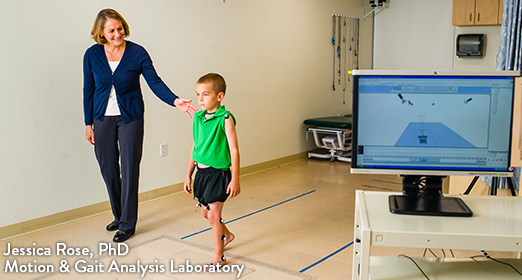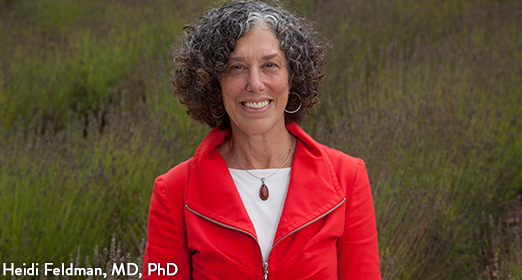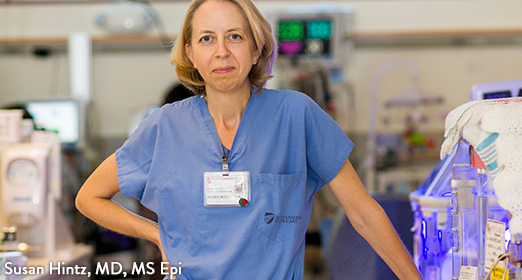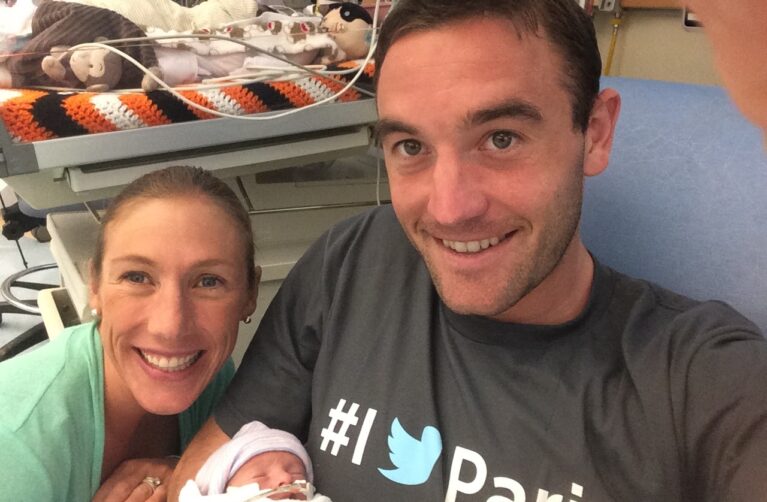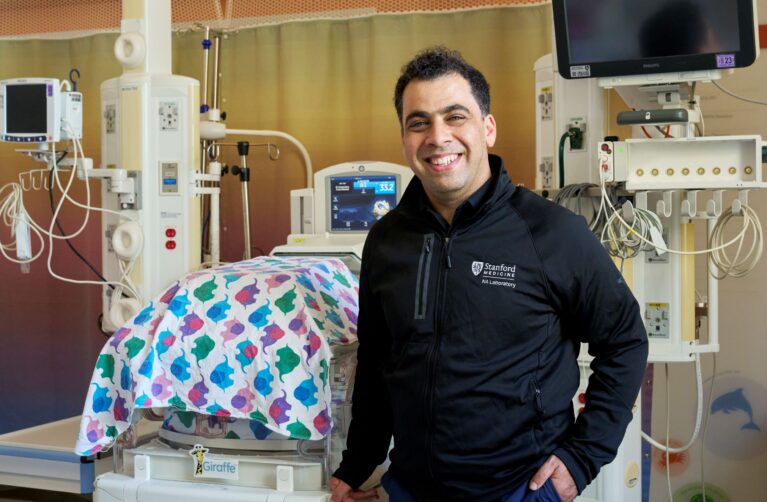Fifty years ago, a premature baby weighing less than 3.3 pounds had only a 30 percent chance of survival. Today, thanks to major advances in neonatal medicine, the survival rate has climbed to nearly 80 percent.
But how do these “preemies” fare once they leave the neonatal intensive care unit (NICU)?
Many grow up to be healthy adults. But half of newborns with extremely low birth weight will develop problems with learning, and one in 10 will develop cerebral palsy.
To address these issues, scientists at Lucile Packard Children’s Hospital and Stanford University School of Medicine are searching for clues to identify early signs of developmental disorders and advancing intervention strategies to improve outcomes for NICU graduates.
Trajectory of Care
Long-term follow-up is the key to better outcomes for preterm children, says neonatologist Susan Hintz, MD, MS Epi, who is also professor of pediatrics at Stanford and medical director of the hospital’s Fetal and Pregnancy Health Program in the Johnson Center for Pregnancy and Newborn Services.
“We need to move toward a smooth trajectory of care that starts with the expectant mother, goes through the neonatal period, and continues all the way through childhood,” Hintz says. “It is very important for families to have consistent follow-up with a team of developmental pediatricians, occupational therapists, physical therapists, and others who can recognize the early signs of developmental, behavioral, language, or motor challenges.”
One such specialist is Jessica Rose, PhD, director of the Motion & Gait Analysis Laboratory and associate professor of pediatric orthopaedics at Stanford, who has evaluated hundreds of young children with symptoms of cerebral palsy, such as problems with muscle control, walking, and balance.
Children who are unable to walk by age 2 are often diagnosed with cerebral palsy. Yet studies suggest that treating a child before these symptoms appear can result in better outcomes.
There is evidence that early intervention works well if it’s intensive and strategic, Rose says. She points to new research showing that 60 hours of intensive upper-limb activity over a two-week period can improve muscle control in young children with cerebral palsy.
Unfortunately, Rose says, the vast majority of kids are not getting early intervention, because it is not currently possible to accurately predict which preterm infants will develop motor impairment and other disabilities.
In 2010, in an effort to identify the early-warning signs of cerebral palsy, Rose and her colleagues began recruiting the parents of preterm infants in our hospital’s NICU for a groundbreaking study. The team analyzed blood samples and brain images from 102 newborns, and conducted follow-up examinations 18 to 22 months later.
Each infant was given a routine brain scan at approximately 37 weeks gestational age prior to discharge from the NICU (near the time they would have been full-term) using conventional magnetic resonance imaging (MRI). Sixty-six of the infants also underwent a newer MRI technique known as diffusion tensor imaging (DTI), which creates detailed images of the connective fibers, or white matter, in the brain by tracking the diffusion of water molecules around each fiber.
While the conventional MRIs found evidence of brain abnormalities, this did not correspond to the child’s neurodevelopmental or gait outcomes at 18 to 22 months. The DTI scans showed microstructural problems in two critical areas of white matter: the corpus callosum, which connects the two hemispheres of the brain, and the internal capsule, the region that links the sensory-motor cortex to the brain stem and spinal cord.
“We found that microstructural abnormalities in the corpus callosum and the internal capsule at 37 weeks were significantly correlated to problems with the child’s cognitive and motor development and walking velocity and stability at 18 to 22 months,” Rose says.
Blood samples collected in the NICU provided additional clues. Infants with low amounts of albumin and higher levels of C-reactive protein (CRP) in their bloodstream developed motor and cognitive problems 18 to 22 months later. “CRP and albumin are part of the body’s response to infection and inflammation,” Rose explains. “We found that the level of these proteins during the first two weeks of life was significantly correlated with outcome.”
These results are consistent with studies showing that infections and brain injuries during pregnancy or birth increase a child’s risk of neurodevelopmental problems. But more research is needed in larger populations to confirm the long-term predictive value of neonatal DTI scans and blood-protein analysis, says Rose.
“We are trying to secure funding for a follow-up study to assess each child’s neuromotor performance at age 6,” Rose adds. “Our goal is to find the very best predictive model that will enable us to guide intervention from the moment the child is discharged from the NICU.”
Language and Learning
As they grow older, many children born preterm may also face cognitive challenges.
“About 50 percent of children born more than eight weeks early or at an extremely low birth weight develop problems with language, learning, and executive function,” says Heidi Feldman, MD, PhD, the Ballinger-Swindells Endowed Professor in Developmental and Behavioral Pediatrics at Stanford.
These children score below their peers on assessments of language and reading, and are not as good as peers at planning, organizing, resisting temptation, or focusing. Some develop attention deficit disorder and anxiety, which can persist into adulthood.
Over the past decade, Feldman’s lab has been using brain imaging and behavioral studies to understand the relationship between prematurity and language and reading.
By conducting a statistical analysis of children ages 9 to 16, researchers found three cognitive domains where prematurity contributed specifically to difficulties: verbal memory, reading comprehension, and linguistic processing speed — how quickly the child processes sentences — which may make it harder for children to succeed in a classroom setting.
Feldman began a collaboration with Stanford psychologist Anne Fernald, PhD, to determine at what age slower language processing skills could be detected.
“We found a strong association between the speed at which toddlers process familiar words at age 18 months and the size of their vocabulary at age 3 years,” Feldman says. “This finding suggests that speed of processing may help predict which children are going to learn language efficiently and which ones may experience delays in the development of their vocabulary and other language skills.”
At ages 9 to 16, brain scans of children born preterm indicate a correlation between the structural integrity of the brain’s white matter and language and reading skills.
“Think of the brain as a collection of little computers that are massively interconnected,” Feldman explains. “The white matter of the brain is like the wires that connect the computers. Linguistic speed of processing might be a very sensitive indicator of whether those connections are healthy or injured.”
White matter may also play a role in the development of reading abilities. Feldman’s research has found that compared to full-term kids, children born preterm are less likely to have begun reading at age 6 years. She is now looking at whether characteristics of the white matter predict who is delayed in learning to read and whether the characteristics of white matter change over time and as the child learns to read.
Feldman notes that the ultimate goal is to find novel ways to improve language and reading skills in the children born preterm to reduce their risks for delays and disorders. Right now, education and therapy is not customized to children based on their medical history or their brain characteristics.
“We want to learn whether children born preterm require a different approach than children born at term even if they show similar patterns of developmental delays,” she explains. “We hope to design studies to evaluate the kind of education and therapy these young people should receive in order to gain maximum advantage from their education.”
Broadening Our Reach
The long-term care approach has been adopted more broadly through the statewide High-Risk Infant Follow-Up Quality of Care Initiative, of which Hintz is a co-principal investigator. Sponsored by California Children’s Services (CCS), the initiative brings together more than 70 high-risk infant follow-up programs across the state.
In 2009 CCS began coordinating with the California Perinatal Quality of Care Collaborative, so more than 130 NICUs across the state could work together and share findings. A primary goal for this linked program was to determine whether preterm infants are routinely referred for follow-up visits when they are discharged from the NICU, and how this transition of care from the NICU to the community can be improved.
“The very first step in being able to identify children who could benefit from early intervention is to make sure they are referred to a qualified developmental team,” says Hintz. “In California, every infant weighing less than 3.3 pounds at birth should be referred to a high-risk infant follow-up program. But we found that these referrals only happen about 80 percent of the time.”
For many families, getting to the first follow-up visit can also be a challenge. Hintz and her colleagues are now evaluating the statewide program to identify factors, such as the distance from the home to the follow-up site, clinical circumstances of the child, and other family challenges and program barriers that may keep some children from making it to that all-important initial visit.
On the national level, Hintz is leading a study funded by the National Institute of Child Health and Human Development Neonatal Research Network, which focuses on understanding and improving outcomes for extremely preterm and critically ill newborns. Our hospital is one of only 16 academic centers across the United States to participate in the study.
In the ongoing national study, more than 500 preterm babies, born at least 12 weeks early, had a series of cranial ultrasounds and a brain MRI during their NICU stay. A developmental and neurologic follow-up visit was conducted at 18 to 22 months of age. The study aims to assess the value of early and later neonatal neuroimaging findings over and above other clinical risk factors, and whether cranial ultrasound—the current routine neuroimaging approach—or MRI could better help predict the child’s outcome.
“For this cohort, in general we found that ultrasounds conducted when the infant is just a few days old are less predictive than neuroimaging tests done later on in the NICU stay. However, there are many complexities to an individual baby,” Hintz says. “In neonatology, we have tended to rely heavily on results of early brain ultrasounds to guide conversations with parents, but this is too simplistic. Presenting neonatal neuroimaging results to families as the singular predictive factor for the future of their child is neither appropriate nor accurate.”
Analysis of the MRI scans revealed that white matter abnormalities in combination with injury in the cerebellum could be a valuable predictor of adverse neurodevelopmental outcomes at 18 to 22 months, independent of other factors. But Hintz is cautious about the results.
“Looking at how preterm children are doing at 18 to 22 months of age provides a very narrow window into their outcomes,” she says. Because there are many developmental processes that are not in evidence at such a young age, a more comprehensive study to follow these children to age 6 or 7 is now under way.
“Our quality of care initiatives should not stop at the NICU door,” Hintz adds. “We need to continue to evaluate processes to improve outcomes throughout childhood. Investing in early childhood gives us the opportunity to lift families, communities, and society by helping preterm patients achieve the best they possibly can as adults.”
This article first appeared in the Fall 2014 issue of Lucile Packard Children's News magazine.
